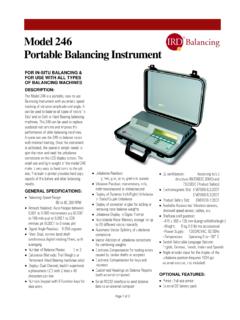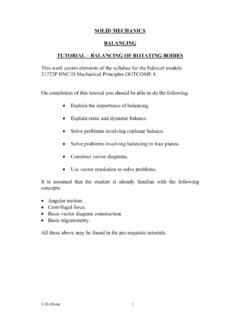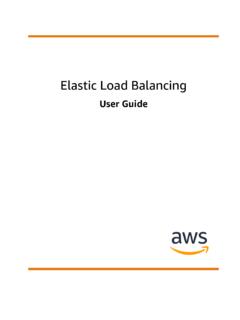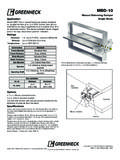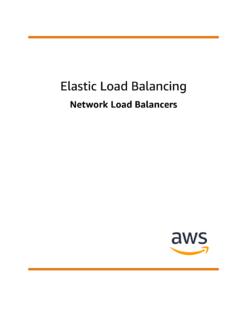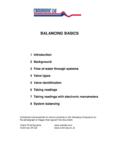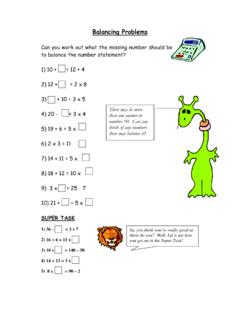Transcription of In-Situ Roll Balancing - Bretech
1 In-Situ roll Balancing : A REVOLUTIONARY METHOD FOR IMPROVING DRYER SECTION PERFORMANCE J Michael Robichaud, Bretech Engineering Ltd 70 Crown Street, Saint John, NB Canada E2L 3V6 email: ABSTRACT: As machine operating speed increases, unbalance forces increase dramatically, leading to equipment reliability and product quality problems. Correcting dryer unbalance presents significant technical challenges, due to slow rotational speeds and phase influence of nearby dryers. A revolutionary new technique has been developed, using regular maintenance shutdowns as the opportunity for incremental corrections.
2 This approach has proven especially valuable during speed-up projects. This paper describes the challenges, solutions, and benefits of the In-Situ roll Balancing technique. KEYWORDS: Balancing , vibration, dryer INTRODUCTION In October 1995, Irving Paper Inc challenged Bretech Engineering Ltd to resolve an existing dryer unbalance problem. At that time, the mill had commenced with a speed-up project, and dryer cylinder unbalance had been detected during a dynamic analysis conducted by Bretech . Mill engineers agreed that corrective action was required, especially since the unbalance forces will increase proportionally to the square of the speed increase (see Eq 1).
3 However, production requirements did not permit an extended shutdown (ie opportunity for corrective action) within the paper machine rebuild project schedule. The conventional method of Balancing dryers is the vector or influence coefficient method. The effect of a trial mass added at a correction plane is measured, and mathematically related to the position and size of the trial mass. With this information, the trial mass can be sized and relocated to eliminate unbalance forces. This technique requires that each dryer is mechanically isolated (ie gear pinions and/or dryer felts removed) and rotated using an external drive mechanism therefore extended shutdowns are required to carry out Balancing of more than 1 dryer.
4 In order to conform to the speed-up project schedule (and achieve production goals), Bretech engineers commenced with development of a new dryer Balancing procedure. The most significant predetermined constraint was that corrective action must be conducted during a scheduled maintenance shutdown. Balancing BASICS ISO 1925 Mechanical vibration Balancing - Vocabulary defines unbalance as: That condition which exists in a rotor when vibratory force or motion is imparted to its bearings as a result of centrifugal forces . Centrifugal forces are generated when the mass center of gravity or principle inertia axis does not correspond with the center of rotation.
5 The amounts and position of rotor mass unbalance are in general unknown and cannot be measured directly. The corrections for mass unbalance must be determined through measurement of the rotor s vibration response to a known trial weight (influence coefficient method). Balancing is both an art and science. The science is involved in the use of single and 2-plane vector graphical or calculator procedures. The art is involved in the selection of balance planes and speeds, as well as trial mass sizes and locations. It must be recognized that field Balancing is performed to minimize vibration at a selected location on a machine.
6 Therefore, a global weight is attached to the rotor to compensate for local mass unbalance at several locations. This may introduce localized stresses in the The forces generated by mass unbalance depend on the mass of the rotor or unbalance weight, its mounted eccentricity, and the rotor speed, as shown in Eq 1 below, where, =2e gWF Eq 1 Force due to Unbalance F = Force due to mass unbalance, lb. W = Rotor Weight, lb g = gravitational constant = in/sec2 e = eccentricity, in = rotor speed, rad/sec Since the force is proportional to the rotor speed squared, residual unbalance may become a serious problem following paper machine speed-ups.
7 There are 2 types of unbalance, static and dynamic, as illustrated in Figs 1 & 2, below. Fig 1 Static Unbalance Fig 2 Couple Unbalance Pure static and pure couple unbalance rarely occur in real rotors; rather some combination of each type, known as Dynamic Unbalance typically occurs. The amount of couple unbalance, indicated by phase relationship of the end planes, provides an indication of whether the unbalance may be resolved using a single plane or 2-plane solution. For conventional Balancing , proper trial mass selection saves valuable time (and may prevent destruction of machinery).
8 Jackson2 has suggested that a trial mass should be used which yields a force of not more than 10% of the static weight of the rotor. For the proposed new Balancing technique, it was proposed that the ideal trial mass vector (magnitude and phase) equals the unbalance force vector. This would permit installation of unbalance correction weights during scheduled maintenance shutdowns. Although the subject of dryer cylinder unbalance is not explicitly dealt with in ISO1940, a target vibration response of in/sec PK was established, mostly from practical experience. This is approximately equivalent to the permissible residual unbalance, uper, allowed by ISO1940 G1.
9 MACHINERY VIBRATION ANALYSISP rincipal Inertia AxisSTATIC UNBALANCECGR otational AxisMACHINERY VIBRATION ANALYSISCOUPLE UNBALANCECGP rincipal Inertia AxisRotational AxisDryer cylinder Balancing inherently presents specific technical challenges; 9 slow rotating speeds (< 300 rpm) 9 phase influence of nearby dryers (see Fig 3) Fig 3 Phase Influence of Nearby Dryers The proposed new method imposed an additional challenge; 9 corrective action must be completed within scheduled maintenance shutdowns, of 12 hours or less PROCEDURE DEVELOPMENT AND TESTING Extensive laboratory and field testing was conducted to evaluate the technical challenges, and proposed solutions.
10 The laboratory test model is shown in Fig 4, below. Fig 4 Laboratory Test Model Several methods, including resonance Balancing and field intensity measurements, were evaluated in detail, with limited practical success. Following extensive testing, a practical application of the influence coefficient method was developed. This technique uses high resolution, high accuracy measurements of the rotating speed vector (magnitude and phase) to calculate the initial trial mass, ensuring a size and location resulting in significant improvement.

